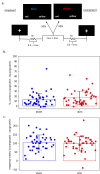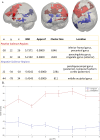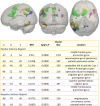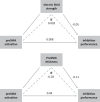Investigating the effects of brain stimulation on the neural substrates of inhibition in patients with OCD: A simultaneous tDCS - fMRI study
- PMID: 40389423
- PMCID: PMC12089465
- DOI: 10.1038/s41398-025-03381-9
Investigating the effects of brain stimulation on the neural substrates of inhibition in patients with OCD: A simultaneous tDCS - fMRI study
Abstract
Inhibition deficits constitute a core characteristic of obsessive-compulsive disorder (OCD). There is evidence in healthy individuals that transcranial direct current stimulation (tDCS) of the pre-supplementary motor area (pre-SMA) leads to a significantly improved inhibition performance. Against this background we investigated the effects of pre-SMA tDCS on inhibition performance and the underlying neural correlates in patients with OCD. Using a double-blind, randomized, sham-controlled, cross-over design (i.e., tDCS sham vs. tDCS stimulation) we investigated the effects of 2 mA anodal tDCS stimulation of the right pre-SMA in a sample of 47 OCD patients. The present study is, to our best knowledge, the first study applying concurrent tDCS-fMRI in patients with OCD. tDCS was applied using the MRI-compatible NeuroConn DC-Stimulator which allowed for a concurrent stimulation, while patients performed an inhibition (i.e., Stroop) task in a 3 T MRI. Imaging data were analysed using a multivariate partial least squares (PLS) approach. tDCS stimulation (vs. sham) was associated with increased activation in a fronto-parieto-cerebellar network comprising, amongst others, the precentral, middle frontal and inferior frontal gyrus, the anterior cingulate and the superior parietal lobe. On the performance level, tDCS stimulation (vs. sham) was linked to an improved inhibition performance in terms of an increased percentage of correct responses in the Stroop task. Present results indicate that tDCS in patients with OCD goes along with an improved inhibition performance as well as activation increases in regions known to be involved in inhibition, motor, and cognitive control. Thus, our findings suggest that tDCS might be a promising method to improve specific impairments in OCD.
© 2025. The Author(s).
Conflict of interest statement
Competing interests: The authors declare no competing interests.
Figures





Similar articles
-
Local effective connectivity changes after transcranial direct current stimulation in obsessive-compulsive disorder patients.J Affect Disord. 2025 Apr 1;374:116-127. doi: 10.1016/j.jad.2025.01.055. Epub 2025 Jan 11. J Affect Disord. 2025. PMID: 39805500 Clinical Trial.
-
Efficacy of pre-supplementary motor area transcranial direct current stimulation for treatment resistant obsessive compulsive disorder: A randomized, double blinded, sham controlled trial.Brain Stimul. 2019 Jul-Aug;12(4):922-929. doi: 10.1016/j.brs.2019.02.005. Epub 2019 Feb 13. Brain Stimul. 2019. PMID: 30808612 Clinical Trial.
-
Increased functional connectivity between presupplementary motor area and inferior frontal gyrus associated with the ability of motor response inhibition in obsessive-compulsive disorder.Hum Brain Mapp. 2022 Feb 15;43(3):974-984. doi: 10.1002/hbm.25699. Epub 2021 Nov 24. Hum Brain Mapp. 2022. PMID: 34816523 Free PMC article.
-
Transcranial cortical stimulation in the treatment of obsessive-compulsive disorders: efficacy studies.Curr Psychiatry Rep. 2015 May;17(5):36. doi: 10.1007/s11920-015-0571-3. Curr Psychiatry Rep. 2015. PMID: 25825002 Review.
-
Brain Stimulation in Obsessive-Compulsive Disorder (OCD): A Systematic Review.Curr Neuropharmacol. 2019;17(8):787-807. doi: 10.2174/1570159X17666190409142555. Curr Neuropharmacol. 2019. PMID: 30963971 Free PMC article.
References
-
- Abramovitch A, Abramowitz JS, Mittelman A. The neuropsychology of adult obsessive-compulsive disorder: a meta-analysis. Clin Psychol Rev. 2013;33:1163–71. - PubMed
-
- Lipszyc J, Schachar R. Inhibitory control and psychopathology: a meta-analysis of studies using the stop signal task. J Int Neuropsychol Soc. 2010;16:1064–76. - PubMed
-
- Mar K, Townes P, Pechlivanoglou P, Arnold P, Schachar R. Obsessive compulsive disorder and response inhibition: Meta-analysis of the stop-signal task. J Psychopathol Clin Sci. 2022;131:152–61. - PubMed
-
- Bannon S, Gonsalvez CJ, Croft RJ, Boyce PM. Response inhibition deficits in obsessive-compulsive disorder. Psychiatry Res. 2002;110:165–74. - PubMed
Publication types
MeSH terms
Grants and funding
LinkOut - more resources
Full Text Sources
Medical

